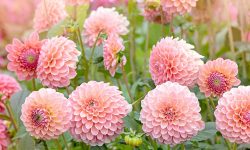Introduction
African violets (Saintpaulia) are one of the most popular indoor flowering plants in the United States. Known for their delicate blossoms and soft, velvety leaves, these plants add a charming splash of color to any room. The real joy of African violets, however, lies in their ability to bloom almost year-round with proper care. While they may seem finicky at first, a little attention to their specific needs can result in continuous, vibrant blooms for months on end.
This comprehensive guide will walk you through every essential aspect of African violet care. From lighting and watering to feeding and repotting, you’ll learn how to maintain healthy, thriving plants that bloom beautifully in every season.
Understanding the African Violet Bloom Cycle

What Triggers Blooms?
African violets bloom in response to a combination of light, temperature, nutrition, and general plant health. They need adequate light, consistent watering, and nutrients to produce buds. A stressed or neglected plant will prioritize survival over flowering, which is why many African violets stop blooming after initial growth.
Blooming Frequency
Under ideal conditions, African violets can bloom continuously or go through short cycles of blooming and rest. Each bloom cycle can last for two to three weeks, followed by a brief dormant phase before new buds appear.
Providing the Right Lighting Conditions
Importance of Light
African violets thrive in bright, indirect light. Natural light from an east or north-facing window is usually best. However, too much direct sunlight can scorch the leaves, while too little light results in leggy growth and a lack of flowers.
Using Artificial Lights
If natural light is insufficient, fluorescent or LED grow lights are excellent alternatives. Place the lights 10 to 12 inches above the plants and keep them on for 12 to 14 hours a day. Consistent lighting ensures that the plant photosynthesizes effectively, fueling the growth of buds and blooms.
Mastering Watering Techniques
Frequency and Method
Watering is one of the most critical and commonly misunderstood aspects of African violet care. Overwatering can cause root rot, while underwatering leads to wilting and bud drop. Always water when the top of the soil feels slightly dry to the touch.
Bottom watering—where you place the pot in a tray of water and allow the soil to absorb moisture—is often recommended. This method helps prevent water from sitting on the leaves, which can lead to spots or rot.
Temperature and Water Quality
Use room-temperature water that has been allowed to sit for at least 24 hours to let any chlorine dissipate. Cold water can shock the roots, while hard water may lead to salt build-up in the soil, affecting the plant’s health.
Choosing the Right Soil and Pot
Soil Requirements
African violets require a light, airy, and well-draining soil mix. A specialized African violet potting mix usually contains peat moss, vermiculite, and perlite, which helps retain moisture without becoming compacted.
Pot Selection
Choose a pot that allows for adequate drainage. African violets prefer to be slightly root-bound, so a small pot—generally 4 to 5 inches in diameter—is ideal. Clay or plastic pots both work well, but self-watering containers can be especially helpful for beginners.
Fertilizing for Continuous Blooms
Balanced Nutrition
To keep your African violets blooming year-round, regular feeding is essential. Use a balanced fertilizer designed specifically for African violets. The fertilizer should contain a mix of nitrogen, phosphorus, and potassium.
Feeding Schedule
Feed your plant every 2 to 4 weeks during active growth, especially in spring and summer. In cooler months, you may reduce the frequency but avoid skipping fertilization entirely. Liquid fertilizers diluted to half strength are usually the safest option.
Managing Temperature and Humidity
Ideal Temperature Range
African violets prefer a stable environment with daytime temperatures between 70°F and 80°F and nighttime temperatures not dropping below 60°F. Avoid placing your plant near drafts, heating vents, or air conditioning units.
Humidity Considerations
These plants thrive in moderate humidity levels of around 50 to 60 percent. If your home is dry, especially in winter, consider using a humidity tray or a room humidifier to maintain ideal conditions. Grouping several plants together can also help raise the local humidity.
Pruning and Grooming
Removing Spent Flowers
Deadheading, or the removal of faded flowers, encourages the plant to focus energy on producing new blooms. Gently pinch off old flowers at the base of the stem to promote fresh bud growth.
Leaf Maintenance
Regularly remove yellowing or damaged leaves to keep the plant healthy and looking its best. Gently brushing dust off the leaves with a soft brush or cloth also helps the plant breathe and photosynthesize more effectively.
Repotting for Long-Term Health
When to Repot
African violets should be repotted every 6 to 12 months, or when the plant becomes root-bound. Signs that it’s time to repot include slow growth, poor blooming, and roots growing out of the drainage holes.
How to Repot
When repotting, trim off any dead roots and remove old soil. Use fresh African violet mix and place the plant in a slightly larger pot if necessary. Water lightly after repotting and allow the plant to settle before resuming regular care.
Common Blooming Problems and Solutions
No Blooms
If your African violet isn’t blooming, reassess its light exposure, watering schedule, and feeding routine. Inconsistent lighting and lack of nutrients are the most common causes of bloom failure.
Bud Drop
Sudden changes in temperature, drafts, or overwatering can lead to bud drop. Ensure stable conditions and gentle handling to avoid stressing the plant.
Leggy Growth
Stretched, leggy growth often indicates insufficient light. Move the plant closer to a light source or install grow lights to promote compact, healthy foliage and more blooms.
Encouraging Reblooming
Allowing a Rest Period
Sometimes, African violets need a short rest after heavy blooming. During this time, reduce fertilization slightly but continue to provide consistent light and moisture. Within a few weeks, the plant will usually begin to form new buds.
Optimizing Conditions
Check all care variables periodically to ensure optimal conditions. Healthy African violets will reward your diligence with another round of stunning blooms.
Frequently Asked Questions
What is the best location for African violets indoors?
African violets flourish in locations that provide bright, indirect sunlight throughout the day. An east-facing windowsill is often the most suitable, as it provides soft morning light that is gentle on the leaves. A north-facing window can also work well, especially in warmer climates, although light may need to be supplemented in winter months.
Avoid placing African violets in windows that receive intense afternoon sun, such as south or west-facing windows, unless you diffuse the light using sheer curtains or blinds. Direct sunlight can burn the delicate leaves and cause faded blooms. If natural light is insufficient, full-spectrum grow lights can be used to simulate ideal lighting conditions and encourage year-round blooming.
How often should I water African violets?
Watering frequency depends on several factors, including temperature, humidity, soil type, and container size. In general, African violets prefer to be watered when the top inch of soil feels slightly dry to the touch. Overwatering or keeping the soil constantly wet can lead to root rot, which is a common cause of plant failure.
Many gardeners prefer the bottom-watering method, where the pot is placed in a shallow tray of water and allowed to absorb moisture through the drainage holes. This method keeps the leaves dry, helping to prevent spotting and fungal issues. Once the soil feels moist, remove the pot from the tray and let excess water drain.
It’s also essential to use room-temperature water, as cold water can shock the roots and cause leaf damage. Water quality matters too—if your tap water is heavily chlorinated or softened with sodium, consider using filtered or distilled water.
Why aren’t my African violets blooming?
If your African violet is healthy but not producing flowers, there are several possible reasons. One of the most common is insufficient light. African violets need at least 12 to 14 hours of bright, indirect light per day to stimulate continuous blooming. If they are in a dim location, consider relocating them or using artificial lighting.
Nutrient deficiencies can also hinder blooming. Fertilizers that are low in phosphorus (the middle number on the fertilizer label, such as 15-30-15) may not support flower production. Use a fertilizer specially formulated for African violets and apply it every 2 to 4 weeks at half strength.
Overwatering, underwatering, rootbound plants, and old soil are other common causes. Make sure the plant has enough space to grow, and repot it annually into fresh soil to maintain ideal nutrient and pH levels. Also, be sure to remove dead blooms and yellowing leaves to redirect the plant’s energy toward producing new flowers.
Do African violets need to be repotted?
Yes, regular repotting is essential for keeping African violets healthy and productive. Over time, the soil in the pot becomes compacted, depleted of nutrients, and less able to retain the right balance of moisture and air. Most experts recommend repotting every 6 to 12 months, even if the plant still appears healthy.
Choose a light, airy soil mix designed specifically for African violets. These mixes typically contain peat moss, vermiculite, and perlite to improve drainage and aeration. When repotting, gently loosen the roots, remove any dead or decaying matter, and place the plant into a clean pot that’s only slightly larger than the previous one.
Avoid using a container that is too large. African violets prefer to be slightly root-bound, which actually encourages them to bloom more prolifically. After repotting, water lightly and place the plant in its regular location to minimize stress.
Can African violets survive in low light?
African violets are tolerant of low light but will not thrive or bloom consistently under these conditions. In low-light environments, they may produce leggy stems, smaller leaves, and fewer or no blooms. For optimal growth, they require moderate to bright indirect light, which mimics their native habitat under the forest canopy.
If your space doesn’t have enough natural light, you can easily supplement with fluorescent grow lights or LED plant lights. Position the lights about 10 to 12 inches above the plant, and keep them on for around 12 to 14 hours a day, turning them off at night to mimic a natural day-night cycle.
Using grow lights allows you to grow African violets in places like offices, bathrooms, or windowless kitchens—anywhere that would otherwise be unsuitable for flowering plants. Proper lighting ensures not just survival, but vibrant foliage and long-lasting blooms throughout the year.
Conclusion
African violets are not only beautiful but also surprisingly adaptable when their basic needs are met. By understanding their blooming cycle and committing to consistent care, you can enjoy flowers nearly every month of the year. With attention to lighting, watering, fertilizing, and overall plant health, your African violets will become a thriving, colorful fixture in your indoor garden.
Whether you’re a beginner or a seasoned plant enthusiast, the journey of keeping African violets blooming year-round is one filled with learning, satisfaction, and vibrant beauty.






